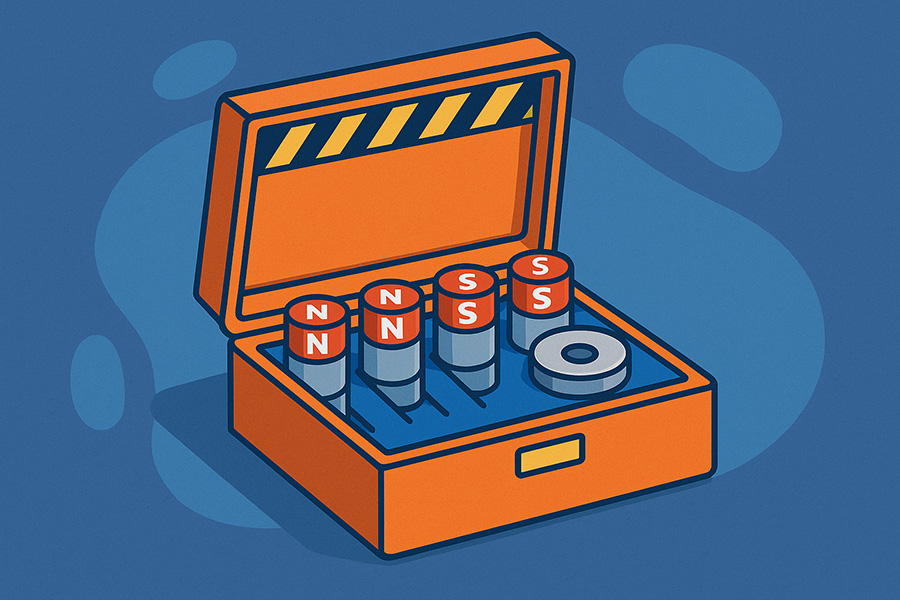Shopping for neodymium magnets, you’ll see “Gauss” mentioned often.
But what does it mean?
Let’s break down everything you need to know about Gauss in simple terms.
Table of Contents
What Exactly is Gauss?
Gauss (G) measures how concentrated a magnetic field is at any point. Simply put, it tells you the magnetic strength – higher numbers mean stronger pull.
Named after scientist Carl Friedrich Gauss, this measurement counts magnetic field lines in a given area. While scientists often use Tesla instead (1 Tesla = 10,000 Gauss), most magnet sellers stick with Gauss in their listings.
For comparison:
- Earth’s magnetic field: about 0.5 Gauss
- Refrigerator magnet: 50-100 Gauss
- Fridge souvenir strip: few hundred Gauss
- Ceramic/ferrite magnet: 1,000-3,000 Gauss on surface
- Small neodymium magnet: 2,000-6,000 Gauss on surface
- Laboratory electromagnets: 10,000-30,000 Gauss
- MRI machine: 15,000-30,000 Gauss
This wide range shows why neodymium magnets have changed so many industries.
They pack incredible strength into small spaces.
Real-World Gauss Values in Neodymium Magnets
Here’s what Gauss values actually mean when you’re shopping:
Entry-Level Magnets
Basic neodymium magnets typically measure 2,000-4,000 Gauss at their surface. Perfect for most home projects and crafts.
Mid-Range Magnets
Quality neodymium magnets usually fall in the 4,000-6,000 Gauss range. These offer serious strength for workshops and light industrial use.
Premium Magnets
High-grade neodymium magnets (N50-N52) can reach 6,000-7,000 Gauss at the surface. These powerhouses excel in demanding applications.
Many manufacturers advertise internal flux density values around 14,000-15,000 Gauss for premium grades. This refers to the material’s theoretical maximum, not what you’ll measure on the surface.
For example, N42 magnets have a Br of about 13,200 Gauss, while N52 magnets reach up to 14,800 Gauss. But even the strongest neodymium magnets rarely exceed 6,000-7,000 Gauss at the surface when measured with a Gauss meter.
The Neodymium Grade System Explained
Neodymium magnets come in various grades that directly affect their strength:
- N35-N38: Entry-level with good performance for basic uses
- N40-N45: Mid-range grades offering excellent balance of strength and cost
- N48-N52: Premium grades providing maximum field strength
The number after “N” shows the maximum energy product (BHmax) of the magnet material, measured in MGOe (Mega-Gauss Oersteds). Higher numbers mean stronger magnets with higher Gauss ratings.
For example:
- N35: ~35 MGOe energy product, Br ~12,000 Gauss
- N42: ~42 MGOe energy product, Br ~13,200 Gauss
- N52: ~52 MGOe energy product, Br ~14,800 Gauss
These numbers refer to the magnet’s internal field in a closed circuit (the material’s maximum potential).
Letters after the grade number tell you about temperature resistance:
- N42: Standard temperature rating (max 80°C/176°F)
- N42M: Medium temperature rating (max 100°C/212°F)
- N42H: High temperature rating (max 120°C/248°F)
- N42SH: Super high temperature rating (max 150°C/302°F)
- N42UH: Ultra high temperature rating (max 180°C/356°F)
- N42EH: Extremely high temperature rating (max 200°C/392°F)
A higher temperature rating often means slightly less magnetic strength at room temperature but better performance when heated.
Why Your Magnets Might Not Match Their Advertised Gauss
Ever ordered magnets rated at 6,000 Gauss but measured different values? Here’s why:
Measurement Location Matters
Magnetic fields aren’t uniform. The reading changes dramatically depending on where you measure.
A disc magnet shows much stronger readings at its poles than along its sides. Even small position changes cause big measurement differences.
Probe Orientation & Position
The reading depends on how and where you measure. For any magnet, the field is usually strongest right at the surface and directly centered on a pole.
The probe must be oriented correctly to get an accurate reading. If you tilt the sensor or move it slightly away, the measured Gauss drops dramatically.
Shape Changes Everything
A cube, sphere, and ring made from identical N42 material will all show different Gauss readings. The shape determines how magnetic flux concentrates.
Manufacturers sometimes list the highest possible reading from the strongest spot. Your measurements may differ based on where you test.
Testing Equipment Variations
Consumer-grade Gauss meters aren’t lab instruments. Different meters can show readings that vary by hundreds of Gauss.
Professional equipment calibration brings consistency that’s hard to match at home.
Surface Field vs. Distance
Magnetic field strength drops rapidly with distance. A reading taken touching the surface will be much higher than one even a few millimeters away.
For example, a 25 mm diameter, 20 mm thick N52 neodymium magnet might measure around 6,250 G at its surface, but the field falls off considerably just a short distance away.
How Professionals Measure Gauss
Wondering how manufacturers get those Gauss numbers? Here’s their process using a specialized instrument called a gaussmeter:
- Equipment Preparation: They use a calibrated gaussmeter with a Hall effect sensor probe that produces voltage proportional to the magnetic field passing through it
- Calibration: They zero the meter to account for ambient fields (including Earth’s magnetic field) – some use a “zero-Gauss chamber” for perfect calibration
- Proper Orientation: They position the probe precisely with the sensor perpendicular to the field lines
- Surface Contact: They place the sensor directly on the magnet’s surface, centered on a pole where the field is strongest
- Stability: They hold everything perfectly still during measurement – even 1mm movement can significantly alter readings
- Multiple Samples: They take multiple readings to ensure accuracy and average the results
Even professional testers get slightly different readings between measurements.
A tilt of just a few degrees or a position change of 1mm can cause variations of hundreds of Gauss.
For standardization, manufacturers typically measure:
- At the exact center of the pole face
- With the probe perpendicular to the surface
- In controlled temperature conditions
- Using equipment with ±1% accuracy or better
When buying a gaussmeter for your own testing, look for one with:
- Resolution of at least 10 Gauss
- Calibration certificate
- Temperature compensation
- A thin probe tip (under 1mm) for accurate surface measurements
Gauss vs. Pull Force: Important Distinction
It’s crucial to understand that Gauss measures field intensity, not total magnetic output. A small magnet might have a very high surface Gauss, but it only exists over a small area.
In practical terms, what matters for lifting or holding objects is:
- Gauss (field intensity)
- Size of the magnetic surface area
- Total magnetic flux (field lines × area)
Here’s a concrete example:
- A tiny 6mm × 3mm N52 neodymium disc might show 5,000 Gauss at its surface but only hold 1.8 pounds (0.8kg)
- A larger 25mm × 5mm N42 magnet might show 4,500 Gauss but hold 11 pounds (5kg)
- An even larger 50mm × 10mm ceramic magnet might show only 2,800 Gauss but still hold 15 pounds (6.8kg)
This relationship is expressed mathematically as:
- Pull force ∝ (Surface area × Gauss²)
- Doubling the diameter of a disc magnet can quadruple its pull force even with the same Gauss rating
This is why manufacturers often specify both Gauss ratings and pull force (usually in pounds or kilograms). The pull force tells you how much weight the magnet can hold in ideal conditions – against a flat, thick piece of steel with direct contact.
Some real-world pull force examples:
- 10mm × 2mm N42 disc: ~3,800 Gauss, 2.5lbs pull
- 20mm × 2mm N42 disc: ~3,800 Gauss, 6.6lbs pull (same Gauss, larger area = more pull)
- 10mm × 5mm N42 disc: ~4,300 Gauss, 5.4lbs pull (thicker = higher Gauss and more pull)
- 10mm × 2mm N52 disc: ~4,200 Gauss, 3.2lbs pull (higher grade = higher Gauss and more pull)
For most practical applications, the pull force specification is more useful than the Gauss rating alone.
What These Numbers Mean For Your Projects
Understanding Gauss helps you choose the right magnets for your needs:
For Home and Craft Projects (2,000-4,000 Gauss)
Most DIY projects work perfectly with 3,000-5,000 Gauss magnets. These provide plenty of strength without excessive cost.
Specific applications:
- Refrigerator magnets: 10mm × 3mm N42 disc (3,800 Gauss) holds 15-20 sheets of paper
- Craft closures: 8mm × 2mm N42 disc (3,700 Gauss) works through 1-2mm of fabric or leather
- Tool organization: 25mm × 5mm N35 disc (3,500 Gauss) holds screwdrivers weighing up to 0.5lbs
- Cabinet latches: 10mm × 5mm N42 block (4,000 Gauss) provides reliable closure through 2-3mm gaps
For Commercial Applications (4,000-5,500 Gauss)
Professional signage, closures, and displays often require 5,000+ Gauss magnets. These provide reliable performance in demanding environments.
Specific applications:
- Retail displays: 20mm × 10mm N45 disc (5,200 Gauss) holds signs weighing up to 5lbs
- Furniture hardware: 15mm × 8mm N45 countersunk (5,000 Gauss) supports panels through 4mm wood
- Vehicle signage: 30mm × 5mm N42 with adhesive (4,800 Gauss) withstands highway speeds
- Display lighting: 12mm × 5mm N42 cylinder (4,500 Gauss) secures fixtures through plastic housings
For Industrial Uses (5,500-7,000 Gauss)
Specialized applications often demand 6,000+ Gauss ratings.
These premium magnets excel in motors, sensors, and recovery equipment.
Specific applications:
- Magnetic sweepers: 100mm × 20mm N50 block array (6,200 Gauss) retrieves metal debris from floors
- Sensor activation: 10mm × 10mm N52 cube (6,500 Gauss) triggers Hall sensors at distances up to 15mm
- Motor components: Custom-shaped N48H segments (5,800 Gauss) maintain performance at up to 120°C
- Heavy mounting: 50mm × 20mm N52 disc (6,700 Gauss) supports loads over 175lbs on steel surfaces
The strongest N52 magnets can hold over 100 times their own weight.
This makes them perfect for salvage operations and heavy-duty mounting.
Field Strength at Distance
Remember that Gauss drops rapidly with distance.
A 25mm × 10mm N52 disc (6,200 Gauss at surface):
- At 1mm distance: ~3,800 Gauss (61% of surface reading)
- At 5mm distance: ~1,500 Gauss (24% of surface reading)
- At 10mm distance: ~650 Gauss (10% of surface reading)
- At 25mm distance: ~120 Gauss (2% of surface reading)
Comparing Neodymium to Other Magnet Types
To appreciate why neodymium magnets are special, let’s compare their Gauss ratings to other common magnet types:
Neodymium (NdFeB)
- Highest remanent flux density: 12,000-14,800 Gauss internally
- Surface readings typically 2,000-7,000 Gauss depending on size and grade
- Strongest permanent magnets commercially available
Samarium Cobalt (SmCo)
- Second-strongest permanent magnets
- Typical remanence: 10,000-11,000 Gauss
- About 75-80% of neodymium’s field strength
- Better temperature stability than neodymium
Alnico
- Surprisingly high remanence: around 12,000 Gauss for grade 5
- Surface readings can reach 5,000-6,000 Gauss in optimal shapes
- Lower coercivity means they demagnetize more easily
- Excellent temperature stability
Ceramic/Ferrite
- Much weaker: 3,000-4,000 Gauss remanence
- Only about 25% of neodymium’s field intensity
- Very affordable and excellent temperature resistance
- Common in speakers, motors, and refrigerator magnets
Flexible Rubber Magnets
- Weakest type: a few hundred to 1,100 Gauss
- Used where flexibility matters more than strength
- Common in refrigerator magnets and flexible sheets
This comparison shows why neodymium magnets have enabled so many modern applications that weren’t possible with older magnet types.
Practical Buying Tips
When shopping for neodymium magnets, keep these points in mind:
Don’t Chase Numbers Alone
The highest Gauss rating isn’t always best. Consider size, shape, and coating based on your specific needs.
A smaller N52 might have higher Gauss but less total lifting power than a larger N42 magnet. Total magnetic flux matters more than peak density for many applications.
Size and Shape Considerations
The dimensions of the magnet dramatically affect the Gauss you actually get. A longer/thicker magnet (in the magnetization direction) will generally have a higher surface Gauss than a very thin magnet of the same grade.
A larger face doesn’t increase the Gauss at the face center but does increase the total magnetic flux and the area over which the strong field is present.
Check Distance Ratings
Surface Gauss drops dramatically with distance. A 6,000 Gauss magnet might only register 1,000 Gauss just 5mm away.
Good sellers provide pull force measurements at various distances. These prove more practical than raw Gauss numbers for most buyers.
Consider Temperature Needs
Higher-grade magnets (like N52) lose strength faster at high temperatures. If your project faces heat, a slightly lower grade with temperature stabilization might work better.
Standard neodymium magnets start losing strength above 80°C (176°F). Special high-temperature formulations maintain performance up to 200°C (392°F).
N42SH (high-temp) might outperform an N52 standard in hot environments since it maintains its magnetization better when heated.
Look Beyond Gauss
Coatings affect a magnet’s practical usefulness more than small Gauss differences. Nickel plating offers good protection, while gold provides superior corrosion resistance.
Triple-layer Ni-Cu-Ni coating has become the industry standard for durability. This protection prevents the raw neodymium material from crumbling due to oxidation.
Safety First: Respecting Strong Magnets
These impressive Gauss ratings come with important safety considerations:
Physical Hazards
Pinch injuries
Neodymium magnets with over 3,000 Gauss can cause serious pinch injuries.
Two 25mm × 5mm N42 discs snapping together can pinch skin with over 20 pounds of force.
Shattering risk
Neodymium is brittle.
When strong magnets collide, they can shatter and send sharp fragments flying at high speed.
Always wear eye protection when handling large magnets.
Tool attraction
A 50mm N52 magnet can violently attract metal tools from over 30cm away.
Clear workspaces of metal objects before handling strong magnets.
Electronic Interference
- Magnetic media: Fields above 50 Gauss can damage magnetic storage. A typical N42 disc affects hard drives from 5-10cm away.
- Pacemakers and medical implants: 5+ Gauss can interfere with these devices. People with implants should stay at least 15-30cm from strong magnets.
- Electronic devices: Fields above 200 Gauss can disrupt or damage electronic components. Smartphones may experience compass errors near fields of just 20 Gauss.
Professional Safety Standards
Many facilities that use very strong magnets (like MRI machines) establish a “5 Gauss line” boundary. Beyond this perimeter, the field drops below 5 Gauss, which is considered safe for people with implanted medical devices.
For context, MRI machines generate 15,000-30,000 Gauss fields, but their 5 Gauss safety line might extend 3+ meters from the machine.
Child Safety
Children should never play with neodymium magnets. If swallowed, they can cause life-threatening intestinal injuries:
- Two 10mm × 5mm magnets can attract through 8cm of tissue with enough force to cause intestinal perforation
- Medical intervention is required immediately if magnets are swallowed
- Keep all neodymium magnets away from children under 14 years old
The stronger the Gauss rating, the more these safety concerns apply.
Always handle high-strength magnets with proper caution, especially those above 5,000 Gauss.
Got Questions?
Need help choosing the right magnet strength for your project?
Send us an email and we’ll help you find the perfect match!



